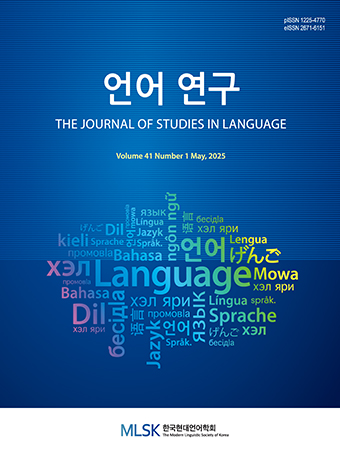Research Article
Abstract
References
Information
This study aims to examine interaction types and cognitive processes involved in Web-based discussions among first-year university students in Korea. 38 students performed 20 minute synchronous written communication by using their Smartphone Kakao Talk application. Their 4 week discussion transcripts were collected and analyzed. The results reveal that two-way messages were more prevalent (75.5%) than one-way interactions and that the cognitive process of Exploration was much more frequently employed (96%). The Web-based discussion is assumed to have contributed to sharing opinions or experiences rather than integrating their ideas as well as promoting confidence in English writing and communication.
- 김성연. 2011. 영어 쓰기 수업에서의 의미협상: 실시간 CMC 활용 쓰기 과업을 중심으로. 『영어교육연구』 16, 135-66.
- 김재경 ‧ 송기상. 2012. 웹기반 쓰기와 스마트 미디어를 활용한 모바일 기반 영어쓰기의 비교. 『한국정보기술학회논문지』 10, 197-204.
- 김희배 ‧ 연고운. 2015. 스마트미디어를 활용한 토론수업의 효과분석: 웹기반 수업과의 비교를 중심으로. 『교육정보미디어연구』 21, 645-65.
- 박인우 ‧ 박은실. 2000. 영어회화수업에서 의사소통 방식과 학습자 특성 간의 상호작용 효과. 『교육공학연구』 16, 114-36.
- 윤경옥 ‧ 나양온. 2015. 대학 영어 수업에서 스마트 폰 앱의 활용과 그에 대한 인식 조사. 『인문학연구』 101, 513-33.
- 서정목. 2015. 플립러닝을 활용한 교양교과목의 융복합적인 운영에 관한 연구-스크린 영어, SNS 영어 및 TED 영어를 중심으로. 『교양교육연구』 9, 193-214.
- 이상수. 2004. 면대면 학습 환경과 온라인 실시간/비실시간 학습 환경에서의 상호작용 패턴 분석. 『교육공학연구』 20, 63-88.
- 정양수. 2009. CMC 기반의 영어 학습에서 과제형태에 따른 상호작용의 유형에 관한 연구. 『영어학 연구』 27, 69-91.
- 한종임. 2009. 동시성 컴퓨터 매개 문자기반 표현 활동의 영어말하기 능력에의 전이가능성 연구: 코퍼스와 엔비보 분석을 중심으로. 『영어교육』 64, 439-67.
- Ahmed, M. K. 2018. Multimedia Aided Language Teaching: An Ideal Pedagogy in the English Language Teaching of Bangladesh. American Interactional Journal of Social Science Research 3. 39-47.
- Archer, W., D. Garrison, R. Anderson, and L. Bourke. 2001. A Framework for Analyzing Critical Thinking in Computer Conference. Paper presented at EURO-CSCL 2001, Maastricht, The Netherlands.
- Chang, J. 2003. Quasi‐Spoken Interactions in CMC: E-mail and Chatting Content Analysis. English Teaching 58, 95-122.
- Cho, Y. and S. Shin. 2004. The Effects of Asynchronous On-line Discussion Boards on International Students’ Participation and Academic Confidence. Korean Journal of Applied Linguistics 20, 17-35.
- Cummins, J. 1984. Bilingualism and Special Education: Issues in Assessment and Pedagogy. Clevedon, England: Multilingual Matters.
- Garrison, D., R. Anderson, and W. Archer. 2001. Critical Thinking, Cognitive Presence, and Computer Conference in Distance Education. American Journal of Distance Education 15, 7-23. 10.1080/08923640109527071
- Gilbert, L. and D. Moore. 1998. Building Interactivity into Web Courses: Tools for Social and Instructional Interaction. Educational Technology 38, 29-35.
- Gunuc, S. and Babacan, N. 2017. Technology Integration in English Language Teaching and Learning. The Journal of Teaching English for Specific and Academic Purposes 5, 349-358.
- Han, M. 2006. Interaction through Web-based Discussions in Teacher Education. English Language Teaching 18, 25-48.
- Hara, N., C. Bonk, and C. Angeli. 2000. Content Analysis of Online Discussion in an Applied Educational Psychology Course. Instructional Science 23, 115-52. 10.1023/A:1003764722829
- Jung, H. J. 2015. Fostering an English teaching environment: Factors influencing English as a Foreign Language Teacher’s Adoption of Mobile Learning. Informatics in Education 14, 219-241. 10.15388/infedu.2015.13
- Kamhi-Stein, D. 2000. Looking to the Future of TESOL Teacher Education: Web Based Bulletin Board Discussions in a Methods Course. TESOL Quarterly 34, 423-56. 10.2307/3587738
- Kanuka, H. and T. Anderson. 1998. Online Social Interchange, Discord, and Knowledge Construction. Journal of Distance Education 13, 57-74.
- Kim, S. H. 2008. Moderating Effect of Job Relevance and Experience on Mobile Wireless Technology Acceptance: Adoption of a Smartphone by Individual. Information & Management 45, 387-393. 10.1016/j.im.2008.05.002
- Lee, S. 2003. Korean ESL Learners’ Experiences in Computer Assisted Classroom Discussion. English Education 58, 371-95.
- Li, Y. 2000. Linguistic Characteristics of ESL Writing in Task-based E-mail Activities. System 28, 229-245. 10.1016/S0346-251X(00)00009-9
- Pawan, F., T. Paulus, S. Yalcin, and C. Chang. 2003. Online Learning: Patterns of Engagement and Interaction among In‐service Teachers. Language Learning & Technology 7, 119-40.
- Shih, J. L., H. Chu, G. Hwang, and Kinshuk. 2010. An Investigation of Attitudes of Students and Teachers about Participating in a Context-aware Ubiquitous Learning Activity. British Journal of Educational Technology 42, 373-394. 10.1111/j.1467-8535.2009.01020.x
- Shim, Y. 2007. Negotiation of Meaning between an L2 Teacher and Students in Face-to-face Interactions and CMC. English Teaching 62, 265-88. 10.15858/engtea.62.3.200709.265
- Smith, B 2003. Computer-mediated Negotiation Interaction: An Expanded Model. Modern Language Journal 87, 38-57. 10.1111/1540-4781.00177
- Sullivan, N. and E. Pratt. 1996. A Comparative Study of Two ESL Writing Environments: A Computer Assisted Classroom and a Traditional Oral Classroom. System 29, 491-501. 10.1016/S0346-251X(96)00044-9
- Tiene, D. 2000. Online Discussions: A Survey of Advantages and Disadvantages Compared to Computer-assisted Classroom and a Traditional Oral Classroom. Journal of Educational Multimedia and Hypermedia 99, 371-84.
- Warschauer, M. and D. Healey. 1998. Computer and Language Learning: An Overview. Language Teaching 31, 57-71. 10.1017/S0261444800012970
- Publisher :The Modern Linguistic Society of Korea
- Publisher(Ko) :한국현대언어학회
- Journal Title :The Journal of Studies in Language
- Journal Title(Ko) :언어연구
- Volume : 35
- No :2
- Pages :221-236
- DOI :https://doi.org/10.18627/jslg.35.2.201908.221




 The Journal of Studies in Language
The Journal of Studies in Language






